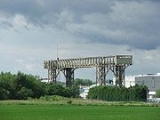
Warrington Transporter Bridge
Encyclopedia
The Warrington
Transporter Bridge (or Bank Quay
Transporter Bridge) across the River Mersey
is a structural steel
transporter bridge
with a span of 200 feet. It is 30 feet wide, and 76 feet above high water level, with an overall length of 339 feet. It was built in 1915 and, although it has been out of use since circa 1964, it is still standing.
It was originally one of two such bridges across the Mersey, the other one being the Widnes-Runcorn Transporter Bridge
(built in 1905). It was designed by William Henry Hunter and built by William Arrol
.
It is privately owned and was built to connect the two parts of the large chemical
and soap works of Joseph Crosfield and Sons
. It was originally used to carry rail vehicles up to 18 tons in weight, and was converted for road vehicles in 1940. In 1953 it was modified to carry loads of up to 30 tons.
English Heritage
designated the bridge as a Grade II* listed building, and as a scheduled monument. Because of its poor condition it is on their Buildings at Risk Register.
Warrington
Warrington is a town, borough and unitary authority area of Cheshire, England. It stands on the banks of the River Mersey, which is tidal to the west of the weir at Howley. It lies 16 miles east of Liverpool, 19 miles west of Manchester and 8 miles south of St Helens...
Transporter Bridge (or Bank Quay
Warrington Bank Quay railway station
Warrington Bank Quay railway station is a mainline railway station serving the UK town of Warrington. The town centre has two stations on opposite sides of the main shopping area, Warrington Central operating a more frequent service to the neighbouring cities Liverpool and Manchester...
Transporter Bridge) across the River Mersey
River Mersey
The River Mersey is a river in North West England. It is around long, stretching from Stockport, Greater Manchester, and ending at Liverpool Bay, Merseyside. For centuries, it formed part of the ancient county divide between Lancashire and Cheshire....
is a structural steel
Structural steel
Structural steel is steel construction material, a profile, formed with a specific shape or cross section and certain standards of chemical composition and mechanical properties...
transporter bridge
Transporter bridge
A transporter bridge is a type of movable bridge that carries a segment of roadway across a river. The gondola is slung from a tall span by wires or a metal frame. The design has been used to cross navigable rivers or other bodies of water, where there is a requirement for ship traffic to be...
with a span of 200 feet. It is 30 feet wide, and 76 feet above high water level, with an overall length of 339 feet. It was built in 1915 and, although it has been out of use since circa 1964, it is still standing.
It was originally one of two such bridges across the Mersey, the other one being the Widnes-Runcorn Transporter Bridge
Widnes-Runcorn Transporter Bridge
The Runcorn-Widnes Transporter Bridge crossed the river Mersey and Manchester Ship Canal linking the towns of Runcorn and Widnes. It was completed in 1905, it was Britain's first transporter bridge and the largest of its type ever built in the world. It continued in use until 1961 when it was...
(built in 1905). It was designed by William Henry Hunter and built by William Arrol
William Arrol
Sir William Arrol was a Scottish civil engineer, bridge builder, and Liberal Party politician.The son of a spinner, he was born in Houston, Renfrewshire, and started work in a cotton mill at only 9 years of age. He started training as a blacksmith by age 13, and went on to learn mechanics and...
.
It is privately owned and was built to connect the two parts of the large chemical
Chemical plant
A chemical plant is an industrial process plant that manufactures chemicals, usually on a large scale. The general objective of a chemical plant is to create new material wealth via the chemical or biological transformation and or separation of materials. Chemical plants use special equipment,...
and soap works of Joseph Crosfield and Sons
Joseph Crosfield
Joseph Crosfield was a businessman who established a soap and chemical manufacturing business in Warrington, which was in the historic county of Lancashire and is now in the ceremonial county of Cheshire...
. It was originally used to carry rail vehicles up to 18 tons in weight, and was converted for road vehicles in 1940. In 1953 it was modified to carry loads of up to 30 tons.
English Heritage
English Heritage
English Heritage . is an executive non-departmental public body of the British Government sponsored by the Department for Culture, Media and Sport...
designated the bridge as a Grade II* listed building, and as a scheduled monument. Because of its poor condition it is on their Buildings at Risk Register.

